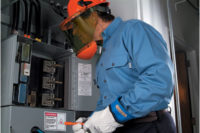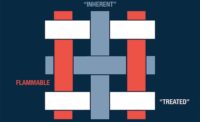
Many people believe that switching from poly/cotton blend work garments to non-flame resistant 100% cotton is an “upgrade†in safety when it comes to electric arc flash. Safety experts across the country today are busy trying to dispel this very dangerous myth. The only thing “safer†about 100% non-FR cotton is that it does not melt, as opposed to the polyester component of poly/cotton blends, which does melt. However, cotton ignites just as easily as blends in an arc, burns hotter, and since it is typically worn in heavier weights, provides more fuel for a longer fire. All of this can contribute to more severe and widespread burn injury.
Advances in hazard analysis and recent revisions to important standards, such as NFPA 70E, have put the spotlight on arc flash safety. However, some analysis has also created a false confidence at the low end of the energy scale when it comes to 100% non-FR cotton.
Risk potential of non-FR cotton
There are four reasons why 100% non-FR cotton is never 100% guaranteed not to ignite in an arc. Some of these reasons or “risks†are tied to the ASTM lab procedures, which lack several critical real-world aspects, while others involve human and equipment error.Risk #1 Lab arcs vs. real-world arcs— Laboratory arcs are designed to be as repeatable and controllable as possible, which is wise and necessary for any scientific procedure. However, they do not accurately reproduce real arcs in the industrial workplace, and the key areas of difference are potentially fatal to wearers of non-FR garments. The areas of concern are molten metal, arc movement and directionality.
Molten metal. The ASTM equipment, when arcing, releases very little molten metal, because the arc gap is large, the electrodes don’t have nearly the mass of metal present in most industrial equipment and the wire that runs the gap is very thin. Why does any of this matter? Because non-FR garments ignite at temperatures of 450-750°F, and molten metal is typically over 1,900°F. Thus, even when the arc energy itself has been calculated to be below ignition thresholds, molten metal can cause point source ignition of non-FR fabrics, which could quickly spread to the entire garment.
Arc movement. Ignition thresholds were calculated with the fabrics 12 inches from an arc, which was essentially fixed in space by a Faraday cage. The arcs in the lab “stay home,†which is sensible and necessary. But arcs in the real world can and do “wander.†Many videos show “arc plasma balls†moving around and even project many feet outward with the cycle pulses. Now a 1.1 cal exposure at 18 inches might be 7 cals at 2 inches, because the arc has traveled outward from the equipment, causing garment ignition and catastrophic injury or death.
Directionality. ASTM arcs used to calculate ignition thresholds are open-air arcs. That is, they occur in space between two vertical electrodes, with no confinement of any kind; thus, they dissipate energy 360 degrees spherically. However, virtually all industrial arcs occur in equipment that restricts the arc in one or more planes (i.e. disconnects, panel boards, meters, etc). This means virtually all industrial arcs will concentrate all their energy in only half the space (180 degrees) or less, focusing the arc flash radiant energy and molten metal, usually directly at the worker.
Risk #2 Ignition threshold data for non-FR garments— Lab work defining “safe†energies for non-FR cotton is conducted on new garments. In real life, workers’ garments are only new until the first job is under way. This leads to three significant factors that can each seriously negatively impact ignition threshold: ignition points, flammable contaminants and fabric softeners.
Ignition points.100% cotton garments can fray and get “fuzzier†over time. These areas can serve as ignition points and trigger garment ignition at much lower energies. In non-FR garments, once garment ignition occurs it will support combustion and quickly spread to areas beyond the initial ignition point, which can result in catastrophic injuries or death.
Flammable contaminants. In use, a significant percentage of electricians and maintenance workers can be expected to at least occasionally get flammable contaminants on their garments. These flammable contaminants will burn in an arc regardless of whether the base fabric is FR or non-FR. However, on a non-FR garment the contaminated areas will support combustion of the rest of the garment, causing severe burn injury; conversely, an FR garment will limit fire and burn injury to the immediate area of the contaminant.
Fabric softeners. Fabric softeners are commonplace on non-FR garments; most are flammable. Like other workplace contaminants noted above, this home-introduced contaminant will, over time, help “jump-start†ignition of non-FR garments, potentially causing ignition well below predicted levels.
Risk #3 User error— All HRC (hazard risk category) calculations involve human interpretation and input. Most of the variables are clear and independent, but several require a person to create a number. Two of these — distance and cycle time — can radically change an incident energy number from one that probably won’t cause ignition to one that will.
Work distance. Work distance, the distance to the torso of the worker, is created by the person conducting the analysis. Energy is inversely proportional to distance, and asymptotic. Thus, getting a little closer raises energy a lot, especially inside 15 inches. The hands and a few inches of forearm should be gloved, but a non-FR garment sleeve will almost always be within inches of the arc even if the torso is 18 inches away. Sleeve ignition can quickly spread to the whole upper garment.
Cycle time. Cycle time also plays a large role; as cycle times increase, so does incident energy. The problem here is that most people conducting hazard analysis will input the data for how rapidly a circuit is supposed to open after sensing a fault. However, breakers not regularly exercised — and many or most are not — often will not open as rapidly as specified. Every doubling of cycle time doubles incident energy, and a 2-cycle variable input during hazard analysis can become a 4-cycle arc or worse very easily. This could shift cotton to ignition quickly.
Operator error. Operator errors also fall into this category: the circuit is supposed to be de-energized but is live; the worker is supposed to stay 18 inches away but moves in to 8 inches for leverage, and so on. Any of these common mistakes can result in ignition of non-FR cotton where it had been predicted to be safe.
Risk #4 Equipment failure— This one is the wild-card category. When the equipment fails, all assumptions that went into the hazard analysis fail with it. If a breaker sticks, cycle times, and therefore energy, jump. If there’s a current surge, fault current numbers are too low. If you’re working on part “x†and part “y†fails next to it, your energy assumptions are invalid. Any of these real-world examples, and many others, can increase incident energy beyond ignition thresholds very easily.
Limit the incident
Any one of the above-noted issues that occurs in any given arc flash can easily cause garment ignition and catastrophic or fatal burn injury. Of course, these variables can pop up just as easily to a worker wearing FR clothing, but any “extra†injury caused by the unpredicted event will be limited to the immediate area of the incident, and probably limited in degree as well.Taken in total, there is really no situation, no matter what the calculated hazard is, in which you can rely on 100% cotton for any level of arc flash protection.

